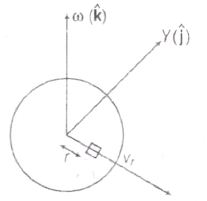Answer:
Option B
Explanation:

$F_{rot}=F_{in}+2m(v_{rot}\hat{i})\times \omega \hat{k}+m(\omega \hat{k}\times r\hat{i})\times \omega \hat{k}$
$mr\omega^{2}\hat{i}=F_{in}+2 mv_{rot}\omega (-\hat{j)}+m\omega^{2}r\hat{j}$
$F_{in}=2mv_{r}\omega \hat{j}$
$r=\frac{R}{4}[e^{\omega t}+e^{-\omega t}]$
$\frac{\text{d}r}{\text{d}t}=v_{r}=\frac{R}{4}[\omega e^{\omega t}- \omega e^{-\omega t}]$
$F_{in}=2m\frac{R\omega}{4}[e^{\omega t}-e^{-\omega t}]w\hat{j}$
$F_{in}=\frac{mR\omega^{2}}{2}[e^{\omega t}-e^{-\omega t}]\hat{j}$
Also , reaction is due to disc surface , then
$F_{reaction}=\frac{mR\omega^{2}}{2}[e^{\omega t}-e^{-\omega t}]\hat{j}+mg\hat{k}$